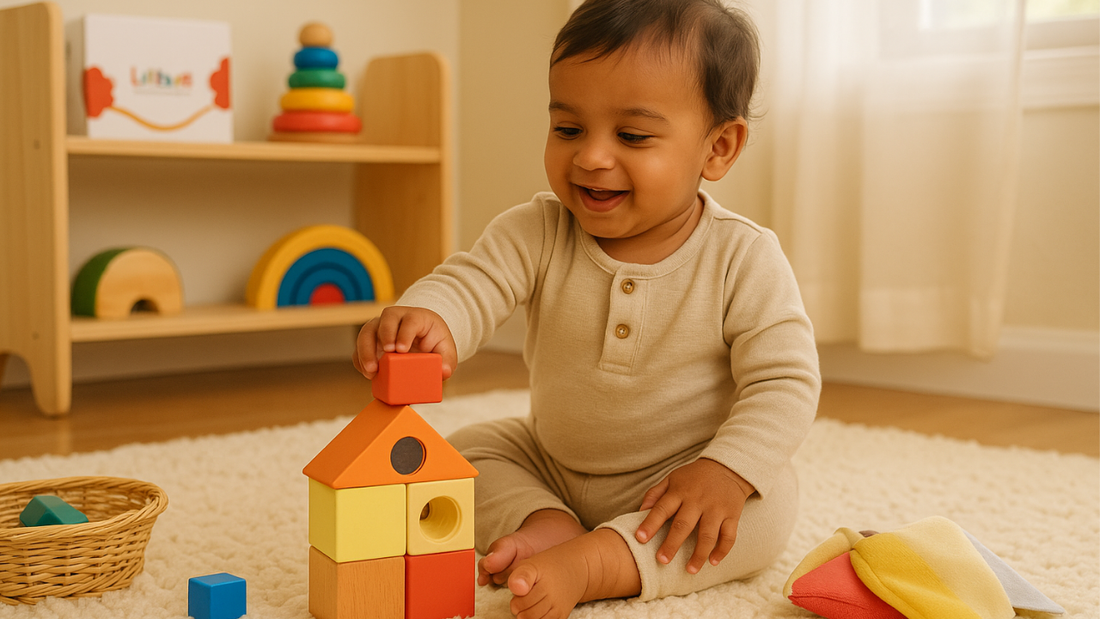
How to Make Old Toys New Again: Rotating and Reimagining for Creative Play
LiLLBUDA simple way to get people excited, curious, and creative again without having to buy more. Kids often get to a point where they look around a room full of toys and say, "There's nothing to play with." It's not that kids need new toys; they just want a new experience.
Parents can keep a child's interest, help them focus, and encourage their creativity by rotating toys and coming up with new ways to play with old ones. All of this can be done while keeping play simple, sustainable, and fun.
What makes toy rotation work
When you rotate toys, you only show a few at a time and keep the rest hidden.
This makes it easier for kids to stay focused and not feel so overwhelmed while they play. When you play with old toys again after a short break, they feel new and fun.
How to Start Rotating Toys
- First, get rid of the clutter: Go through all the toys, get rid of the ones that are broken or not used, and put the rest in order.
- Group by type: Keep toys that are similar to each other together. For example, building toys, puzzles, pretend play toys, and fine motor toys.
- Choose a few to show off: Pick out 8 to 12 toys for kids, depending on how old they are and what they like.
- Put the rest away in labeled bins, baskets, or boxes so they can't be seen.
- Change them out often. Change toys every one to two weeks, or whenever your child seems bored.
Tip: Pay attention to what your child plays with the most. Change some toys more often and rotate others less often.
Reimagining: Finding New Uses for Old Toys
Rotation makes things fun again, but reimagining toys lets kids be creative.
Kids don't always need something new; sometimes they just need to look at it in a new way.
New Ideas for Playing
- Change the setting: put blocks on the kitchen floor, puzzles on the balcony, or play pretend in the garden.
- Mix and match: Take things from different sets and put them together to make something new. For instance, you could use blocks to make homes for animals or combine cars with things around the house to make a city.
- Add real-life things: To make things more interesting, add safe household or natural items like spoons, pebbles, fabric, or cardboard.
- Make "themes" for play: Make a normal day into a mini-event, like "construction day," "color sorting," or "storytime theater."
- Give people the chance to play: Put some toys in a neat pile on a tray or mat to subtly encourage kids to explore.
- Trade toys with friends or family: A short exchange of toys can make old ones feel brand new.
Every little change makes kids want to learn more and use their imaginations in new ways.
The benefits of rotating toys
This easy method helps many parts of a child's growth:
- Better focus and longer attention span: When there are fewer distractions, kids can play more deeply.
- Increases creativity and the ability to solve problems: Using toys in new ways makes you think outside the box.
- Encourages independence: Kids learn to explore without needing new things.
- Encourages mindfulness and sustainability: They learn that happiness doesn't come from having more things, but from using what they already have.
- Makes the environment easier to deal with: A calmer, less cluttered space makes it easier to play and clean up.
How often to switch out toys
There is no one right answer; it depends on how old your child is, what they like, and what they are like. This is a general guide:
|
Age Group |
Number of Toys Out |
Rotation Frequency |
|
6-12 months |
6-8 |
Every 2 weeks |
|
1-2 years |
8-10 |
Every 1–2 weeks |
|
2-3 years |
10-12 |
Every 2–3 weeks |
|
3+ years |
10-15 |
Every 3–4 weeks |
If your child stops playing with certain toys or gets bored easily, it might be time for a change. If they are really into it, wait a little longer before switching again.
Make It Interactive: Involve Your Child
Kids love being a part of the process. Let them help you choose which toys to "wake up" and "take a rest" for playtime. This teaches kids how to be responsible, wait for things, and even deal with their feelings. For example, they learn that missing something makes it more exciting when it comes back. Make rotation day a fun tradition by saying, "Let's see which toys are ready to come back today!"
A Sustainable Approach to Play
Changing the way toys are used and thought about teaches kids about sustainability and how to be mindful consumers from a young age. It teaches them that what makes play fun is not how much they do, but how creative they are. Parents also benefit because fewer toys mean less mess, easier cleaning, and a calmer home.
To get new play out of "old" toys, you don't have to do more; you just have to do less on purpose. When you change the way your child plays with toys and rotate them, you give them space to explore, focus, and come up with new ideas. This makes playtime easier, cleaner, and more fun.
Sometimes, the best play comes from things you already have at home.

